Professional Tips on Managing Plumbing in Older Homes
Professional Tips on Managing Plumbing in Older Homes
Blog Article
The content below relating to Main Plumbing Issues Found in Old Houses is without a doubt stimulating. Read it for yourself and decide what you think about it.

Older homes usually feature beauty, character, and background, yet they can also bring a host of pipes issues. Whether you're dealing with maturing pipes, low tide pressure, or leakages, knowing just how to deal with these common issues is essential to maintaining a risk-free and functional home. In this guide, we'll explore the normal plumbing obstacles faced by older homes and give practical options to maintain your plumbing in top shape.
Recognizing Usual Pipes Concerns
Aging Pipes
Among the most usual issues in older homes is aging pipes. Relying on the era in which your home was constructed, the pipes may be made from products that have degraded over time, such as galvanized steel, cast iron, and even lead. These products can wear away, become fragile, or create leaks, resulting in water damages and possible health hazards.
Low Tide Pressure
If you're experiencing low water pressure, maybe as a result of mineral deposits, rust inside the pipes, or old fixtures that are no longer working efficiently. This can be a major hassle, especially in areas like showers and sinks.
Leaking Pipelines
Leakages are another frequent problem in older homes, usually caused by rusty or damaged pipelines. Even tiny leakages can lead to significant water damages, mold and mildew growth, and increased water bills if not attended to immediately.
Out-of-date Fixtures
Out-of-date pipes components such as taps, commodes, and showerheads not just look old however may likewise be less effective, susceptible to leaks, or incompatible with modern-day pipes criteria.
Pipeline Deterioration
Corrosion is a typical trouble in older pipes, especially those made from galvanized steel or actors iron. Rusty pipes can restrict water flow, cause staining, and eventually lead to leakages or pipeline bursts.
Analyzing the Problem of Your Plumbing
Checking Visible Pipes
Beginning by examining any type of visible pipes in your house, such as those in cellars, crawl spaces, or under sinks. Try to find indications of corrosion, leaks, or corrosion, which can show underlying issues.
Looking for Leakages
Check for leaks by evaluating areas around faucets, bathrooms, and under sinks. You can also check your water meter before and after a duration of no water use to discover concealed leaks.
Water Quality Screening
Older pipelines can influence the high quality of your water. Conduct a water high quality examination to look for contaminants such as lead, rust, or other contaminations that might be presented by maturing pipelines.
Solutions for Common Plumbing Concerns
Replacing Aging Pipes
If your home has old, deteriorating pipelines, think about replacing them with contemporary materials like copper or PEX. This can be a considerable investment, but it will stop future concerns and enhance the safety and security and integrity of your pipes system.
Taking Care Of Low Tide Stress
To repair low tide pressure, begin by cleaning or changing old fixtures and getting rid of mineral buildup in the pipelines. If the problem lingers, it may be needed to replace areas of corroded pipes.
Repairing and Replacing Dripping Pipelines
For little leaks, you can make use of pipe clamps or epoxy putty as a short-lived fix. Nonetheless, it's ideal to replace leaking pipelines completely to stay clear of further damages.
Upgrading Components
Upgrading old components to modern, water-efficient designs can boost your home's plumbing efficiency and decrease water intake. Seek fixtures with the WaterSense label for the best effectiveness.
Managing Pipeline Deterioration
If your pipelines are corroded, replacing them with corrosion-resistant materials like copper, PVC, or PEX is the very best remedy. Routine examinations and water top quality upkeep can help prevent even more rust.
When to Call a Specialist
While some plumbing issues can be managed with DIY options, there are times when it's finest to call a specialist. If you're handling major leaks, comprehensive rust, or are not sure regarding the condition of your pipelines, a qualified plumber can provide expert assessment and repair.
Preventive Upkeep Tips
Normal Inspections
Routinely examine your plumbing system for signs of damage. Capturing problems early can protect against pricey fixings down the line.
Water Stress Guideline
Ensure your water pressure is within the advised array to prevent emphasizing your pipelines and fixtures. A plumbing technician can set up a pressure regulatory authority if needed.
Water Top Quality Upkeep
Install water filters or softeners if your water top quality is poor. This can secure your pipes and fixtures from damage caused by tough water or pollutants.
Positive Pipe Substitute
If your home has very old pipes, consider aggressive replacement before significant problems occur. This can conserve you from emergency situation fixings and water damage.
Conclusion
Managing plumbing issues in older homes requires a combination of vigilance, preventative upkeep, and prompt upgrades. By understanding the usual difficulties and knowing when to seek specialist assistance, you can ensure your pipes system remains useful and trustworthy for years ahead.
9 Common Plumbing Problems in Old Houses
Living in old houses is all about basking in the character of something unique to its time and devoid of the monotony of modern house design. They re appealing for many reasons, namely their appearance, the superiority of materials used in construction, and they re cheap.
The likelihood, however, of something going horribly wrong with the innards of a home built a while ago is much higher than something built in the last 20 or fewer years. Often, you re going to end up paying up for repairs on an old house.
It could be doors and windows not shutting all the way, problems with your roofing, or a shoddy furnace. It could be a lot of things, but one of the more common problems in older homes is with the plumbing.
In this post, we re going to talk about the most common plumbing issues in older homes and how to avoid them. It s time to make yourself aware of these potential issues before it s too late. Let s get started.
Outdated Fixtures
It is true that older fixtures are often made of more solid and overall better materials than their modern counterparts. However, they ll eventually erode with time and inevitably start causing problems.
Handles break, washers and valves deteriorate, causing leaks and nasty smells. If you ve got all original valves, spigots, faucets, and handles in your home, you may way to consider getting them replaced before anything bad happens.
Bad Repairs Over the Years
Unfortunately, your plumbing goes as far as the plumbers that have worked on your home in the past. You re at the mercy of whatever repairs have been done, good or bad. The older your home, the more likely it is that it s had large scale plumbing repairs.
With something particularly old, your house will have had multiple repairs by multiple plumbers and it s impossible to know the amount of care your pipes got. It s probably a good idea to have a good, experienced plumber come in when you buy an old house to diagnose any poor repairs that may have occurred.
Sewer Lines
This isn t really a problem with your old house, but cracked and broken sewer lines could be at the root of your plumbing issues.
Sewer lines are supposed to take away the black and grey water from your drains into the sewer main, and on to the municipal treatment plant. Because sewer lines are always wet, they tend to attract tree roots, which can crack and clog the sewer line.
Shifting Pipes
Pipe bellies can become an issue, especially in old houses. Pipes buried underneath your house or encased in concrete slabs are at the mercy of an old home s gradual movement over the years. It sounds scary, but it happens.
If the pipes happen to shift downwards, they create a belly , which is a negative slope that can restrict the flow of water or create pools that can end up accumulating waste. This can cause clogs and stoppages if left for too long.
Galvanized Piping
If you notice issues with your water pressure, quality, or notice any discoloration, it could be a result of corroding pipes or a release of iron through the pipes. Galvanized pipes are made of iron and then covered with zinc, which can erode over long periods of time.
Lead Service Lines
If your city uses lead service lines and you have galvanized piping, you might run into problems. A service line brings the water from the water main to your home, but if they re being repaired, an influx of lead could appear in your water.
To avoid any water contamination, you should have a plumber examine your pipes and water to determine if there s too much lead. You may have to install a water filtration system in old houses.
Polybutylene Piping
Polybutylene piping was an affordable type of piping used from the 70s until the 90s but isn t accepted by US building codes anymore. It reacts poorly with the oxidants in water and breaks down slowly over time, which has led to entire system failures in some homes.
If you move into a home built during this time, it s a good idea to have a plumber come in and check to see if these pipes are still installed. You may have to get your entire system replaced, if so. It s better to do this now than to potentially cause large scale damage to your home and need your pipes replaced anyways.
Drain Issues
30 plus years of scum, soap, and dirty water will take its toll on your home s drains. Your toilet, as well as your kitchen and bathroom drains, are susceptible to clogging. When you buy an old home, you won t know what s been washed down the drains before you.
If you notice any water backups in any of your sinks, a backed-up toilet, or any strange smells coming from anywhere, then you should get a plumber in to check your drains. Odds are, there s a build-up of debris that will need to be cleared in most old houses.
Better To Be Safe Than Sorry
When you move into an older home that you suspect might have some issues, it s probably a good idea to get a quality plumber in to inspect your pipes, drains, and fixtures. Getting a clean bill of health will give you peace of mind and small fixes now will save you money by avoiding any emergencies down the road.
https://johntheplumberkansascity.com/9-common-plumbing-problems-in-old-houses/

We were brought to that write-up on Plumbing Problems In Old Homes from someone on a different blog. Do you know about somebody who is excited about Common Plumbing Challenges In Old Buildings? Do not hesitate to promote it. I thank you for your readership.
Visit Our Website Report this page